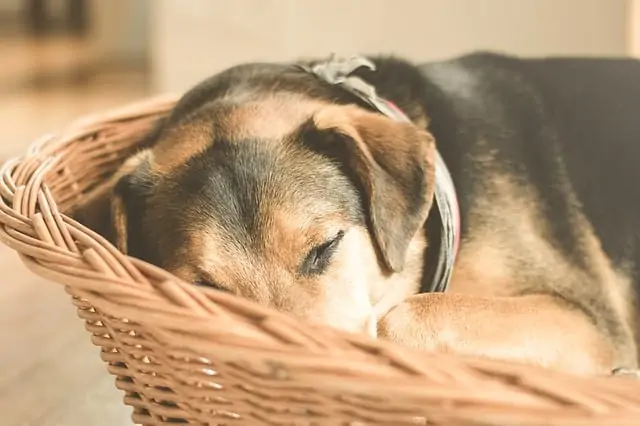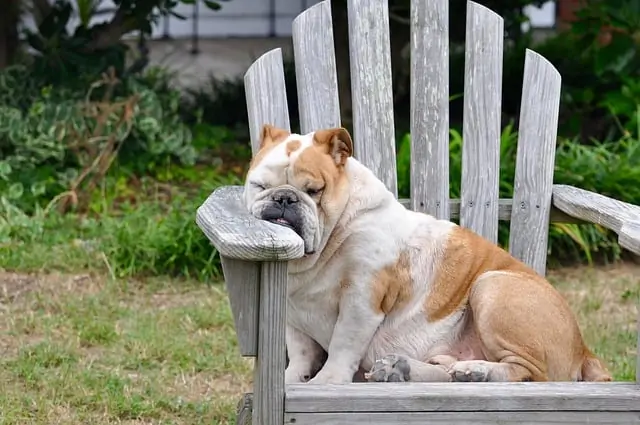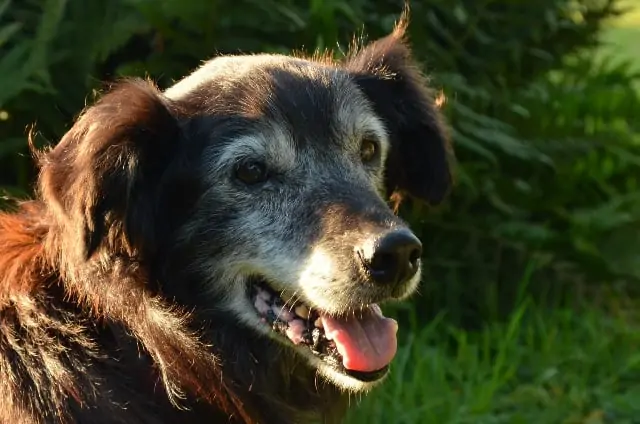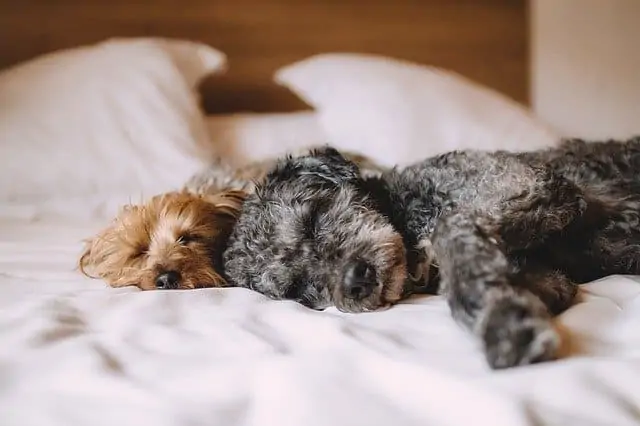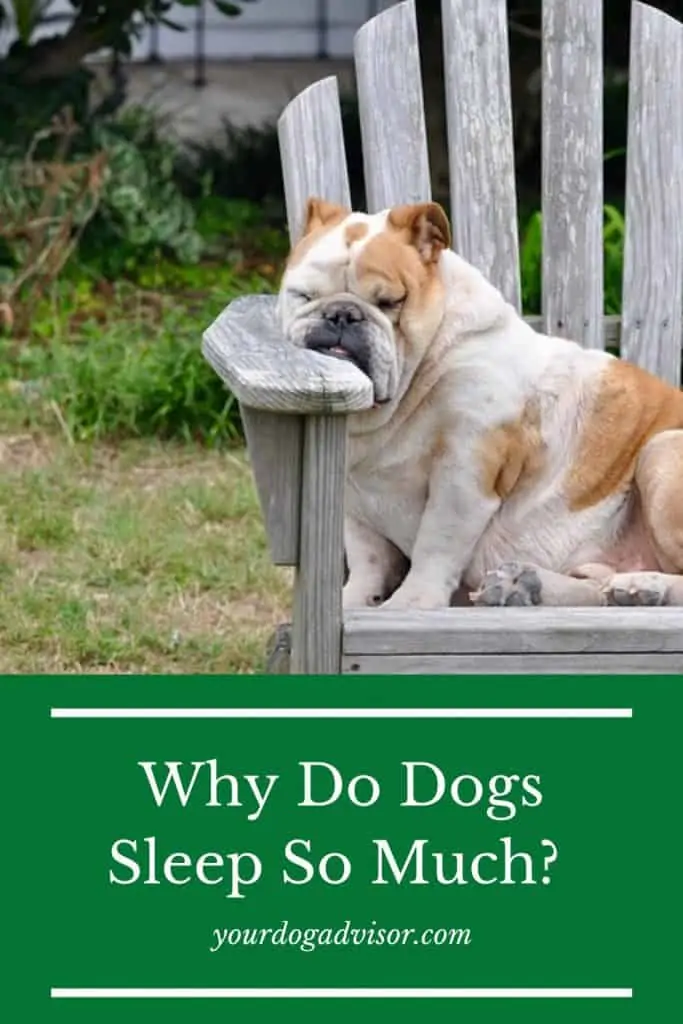If you have ever owned a dog, you’ve probably wondered how it is that he can snooze all morning, take a little walk, snooze most of the afternoon, then settle down for 10 hours of sleep at night. Maybe you’re a little jealous — certainly most of us humans could use a little less stress and a little more down time in our busy lives. But has it ever crossed your mind to wonder “Why do dogs sleep so much?” What is it about our canine friends that makes their sleep-wake cycles so different from ours?
Dogs sleep a lot more than humans do, usually 12-14 hours a day. And it’s not completely clear why.
Contents
Sleep Stages in Dogs and Humans
You may be surprised to learn that the first part of the answer to that question is that dogs and humans actually go through almost identical stages of sleep. These consist of three non-REM or NREM stages, and a REM or rapid-eye-movement stage, during which dreaming occurs. These typically recur in cycles which repeat at intervals throughout the night.
The three NREM stages of sleep are:
- Stage 1 or N1: Stage 1 sleep is a very light sleep that mostly occurs as we transition from wakefulness to sleep. During this phase the sleeper (dog or human) can be woken up easily by movement or noise. During stage 1 sleep, both dogs and humans may experience involuntary muscle contractions known as hypnic jerks.
Stage 1 sleep is usually the shortest sleep stage, lasting about 1 to 5 minutes in humans, and it may not recur throughout the night. Dogs spend very little time in this stage of sleep.
- Stage 2 or N2: In the second stage of sleep, the body slows down and becomes much more calm. The skeletal muscles relax, temperature, breathing and heart rate slow down, and blood pressure drops. Brain activity slows as well and becomes dominated by theta waves, which have a frequency of about 4-8Hz, about half that of alpha waves typically associated with wakefulness.
In humans, N2 sleep usually lasts from 10-25 minutes during the first sleep cycle of the night and becomes longer with each progressive cycle. Both dogs and humans spend about half of their total sleep in Stage 2 sleep.
- Stage 3 or N3: Also known as slow wave sleep, or SWS, this is the deepest stage of nonREM sleep during which the body is very relaxed and vital signs such as temperature and heart rate drop even more. It may be difficult to wake someone — canine or human — from this stage of sleep.
N3 sleep in humans usually lasts from 20- 40 minutes early in the night and shortens with each progressive sleep cycle. In dogs, it lasts about 10-15 minutes per cycle.
Puppies and young dogs like this little guy may experience less muscle atonia during REM sleep and twitch or vocalize while they dream.
REM or rapid-eye-movement sleep occurs later in the sleep cycle — usually after at least 90 minutes of NREM sleep in humans. During this phase of sleep, brain activity picks up and appears very similar to what occurs when we are awake. REM sleep is also associated with temporary muscle paralysis known as atonia; the only muscles not affected are the muscles of breathing and the eyes. In both people and dogs, REM is the stage of sleep when lucid dreaming occurs. The eyes move back and forth rapidly as if they are watching a movie, and some people and animals will vocalize during this time.
In humans, REM sleep takes up about 25% of total sleep time and may last as long as an hour. Dogs, however, only spend about 10-15% of their sleep in REM sleep.
Differences in Dog and Human Sleep
So, you might ask, why do dogs sleep so much more than humans when our sleep patterns are almost the same? The answer lies, at least partly, in the fact that dogs cycle through the stages of sleep far more quickly than their human counterparts. The average human goes through about 5 sleep cycles, including REM sleep, per night. Dogs, on the other hand, may go through as many as 15-20 per night, and wake up more often as a result. These frequent awakenings may account for their needing more sleep (about 10-14 hours total per day on average for an adult.)
Additionally, some experts believe that sleep may be less restorative for dogs than humans because they spend quite a bit less time in REM sleep. Thus, they need to sleep more to get the same benefit from sleep as humans do. However, research into human sleep patterns shows that depriving someone of REM sleep has little or no effect on thinking or behavior. Rather, symptoms of sleep deprivation are associated with deficits in non-REM sleep. So this theory may not be valid after all.
Further, humans are inherently diurnal — we naturally stay awake for about 16 hours during the day and sleep 7-9 hours per night. Dogs, on the other hand, are social sleepers — they take their cues from their owners and sleep when they do. So if you go to bed at 11 p.m. and get up at 7 a.m. every day, your dog will most likely follow suit, even if most of his day was spent snoozing on the couch.
Some dogs seem to have an uncanny ability to sleep anywhere, anytime.
Lastly and perhaps most importantly, dogs are genetically predisposed to rest when they can. Remember, dogs are only separated by a few strands of DNA from their long-ago ancestor, the wolf. And while your pup’s behavior may be far removed from that of wolves in the wild, his brain is still hard-wired towards self-preservation, which means resting and sleeping when the opportunity presents itself in case a threat should come along. This is also probably why dogs wake up so much more easily from sleep than humans do.
Dog Dreams
Have you ever wondered if dogs dream? And if they do, what do they dream about? Anyone who has ever witnessed a dog “chasing rabbits” in his sleep can surmise the answer to that. But how do we really know?
The answer comes in part from an interesting (although ethically questionable) series of experiments conducted on cats in the late 1950s by sleep researcher Michel Jouvet. A neurobiologist with a special interest in sleep and the brain, Jouvet discovered the region of the brain that is responsible for sleep atonia — the paralysis of the muscles that occurs when humans and animals dream. He then deactivated that area (known as the pons) surgically and observed the cats’ behavior as they slept. He found that during REM sleep the cats acted much as they did during the day — stalking prey, grooming themselves, walking, and playing — all while sound asleep. By observing this behavior, Jouvet determined that the cats were dreaming about the activities that they regularly performed.
While he’s sleeping, your dog may relive fun activities in his dreams.
More recently, sleep researchers conducted similar experiments on dogs, this time using a chemical to temporarily deactivate the pons. When the sleeping dogs entered REM sleep, they “acted out” the behaviors they enjoyed while awake — running, playing, jumping and such — while they slept.
So, next time your dog seems to be playing with imaginary playmates or catching an imaginary ball in his sleep, that’s probably what he’s dreaming about. Though you’ll likely see this behavior more often in puppies and younger dogs, in whom the pons is less developed, than in adults.
Sleep Disorders in Dogs
Fortunately, sleep disorders in dogs are rare, although they can occur. Most often, a dog who is sleeping much more than normal or waking up frequently during the night is doing so for a reason not directly related to sleep. For example, many older dogs suffer from arthritis, which causes joint pain that can make sleep difficult. They may wake up frequently during the night and need to sleep more overall to get the rest they need.
Older dogs may also develop a syndrome known as canine cognitive dysfunction or CCD (sometimes referred to as doggy dementia.) Dogs with this condition show a wide range of altered behaviors, including sleeping more overall but less at night, and nighttime restlessness. Some dogs with CDD will wake up after a few hours of nighttime sleep and wander around the house, whining and seemingly confused. These dogs will typically make up for this sleep loss by sleeping more during the day.
Elderly dogs with “doggy dementia” or CDD may wake up confused during the night and sleep long hours during the day.
Medical conditions such as diabetes, thyroid disease, or heart or liver problems may also cause your dog to sleep more than usual. On the other hand, kidney disease, at least in its early stages, can cause your dog to urinate more frequently, so he may wake up more often during the night to go out.
Keep in mind, too, that many dogs sleep simply because there isn’t anything else to do. If you’re concerned about how much your dog is sleeping, try exercising him more often, or give him some puzzle toys to occupy his time. These can be especially helpful for highly intelligent dogs such as German shepherds, and Golden retrievers, who get bored very easily, and working dog breeds, who are happiest when they have a job to do.
Lastly, if you’re concerned about your dog’s sleep habits, let your vet know. They may suggest that you keep a sleep log to track how much your dog is sleeping for a week or two. You should also schedule a check-up, just to rule out any medical problems that may be affecting his sleep.
Helping Your Dog Get His Best Sleep
Sleep is critically important to everyone’s well being, no matter what species they are. Dogs, like humans, can suffer from irritability, depression and other mood changes when they fail to get enough sleep. Poor sleep also affects immune function, hormone balance, energy and even appetite. So, just as you do all you can to ensure that your dog gets the best food, the right amount of exercise, and regular veterinary care, it’s important to make sure he gets a good night’s sleep. But how, you ask, can I accomplish this? Here are a few tips that should help.
As tempting as it is to let your puppies sleep in your bed, they will usually sleep more soundly if they have a comfy bed of their own.
- Invest in a comfy dog bed: Just as you wouldn’t sleep well on a lumpy old mattress, your dog can’t get a good night’s sleep on an old, worn out bed or a bed that’s too small. Shop around for a bed that’s a good fit for your dog’s size, sleep position and personality. (A little dog that likes to curl up in a ball under the covers will need a different bed than a large dog who likes to sleep sprawled on his back!) Think, too, about cushioning. An old dog with arthritis may need a surface like memory foam to support and protect his achy joints.
- Establish a routine: Like children (and adults), your dog will sleep better if he has a consistent schedule, so try to feed, exercise and play with him at around the same times each day. And make sure to have a regular bedtime for him and for yourself. Remember, dogs are social sleepers. So if you hit the sack at 10:00 each night and sleep until 6:30, your dog will probably follow the same routine.
- Take your dog out to relieve himself right before bed: Most of us think we are doing this — after all, few dog owners want to wake up at 3 a.m. to a dog who badly needs to “go.” But in truth, many of us take our dog out to do his last “business,” then come in, grab a snack, watch some TV, then brush our teeth before we lay down to sleep. If you want your dog to sleep through the night, it’s better to take him out right before you go to bed.
- Limit water before bed: This may not be strictly necessary if your dog’s sleep habits don’t include waking up too early because he needs to relieve himself. But, even if your dog can hold his urine for a long time, doing so may be uncomfortable and disrupt his sleep. Unless your dog has a medical condition such as diabetes or kidney disease, he doesn’t need to drink water during the night. It’s perfectly fine to pick up his water bowl a few hours before bedtime.
- Resist the urge to let your dog sleep in your bed: OK, this is a hard one, but if your dog has any sleep issues, it’s an important one, too. Your dog may love snuggling with you (and perhaps your partner) while he falls asleep. But if you’re tossing and turning, snoring, or getting up to go to the bathroom at night, it will absolutely disrupt your dog’s sleep. It’s far better for both of you to set him up in his own special spot on the floor next to your bed so he knows you’re close by but can sleep undisturbed.
The Bottom Line
Dogs sleep a whole lot more than humans do, and, though we think we understand some of the reasons, the truth is that a lot of what we think we know is just a guess. Some dogs are very laid back and want nothing more than to lounge around and snooze all day. (This is especially true of large breeds like mastiffs and Saint Bernards.) For them, sleeping most of the day and night is perfectly normal and no cause for alarm. Similarly, old dogs generally sleep more because their bodies are slowing down. So if your dog is elderly and his excess sleepiness isn’t accompanied by other signs of ill health, you probably shouldn’t be concerned. What is important are any sudden or extreme changes in your dog’s sleep habits — for instance, you suddenly can’t wake him up in the morning or he can’t settle down to sleep at night. These may be signs of a serious illness and should trigger a visit to your vet.
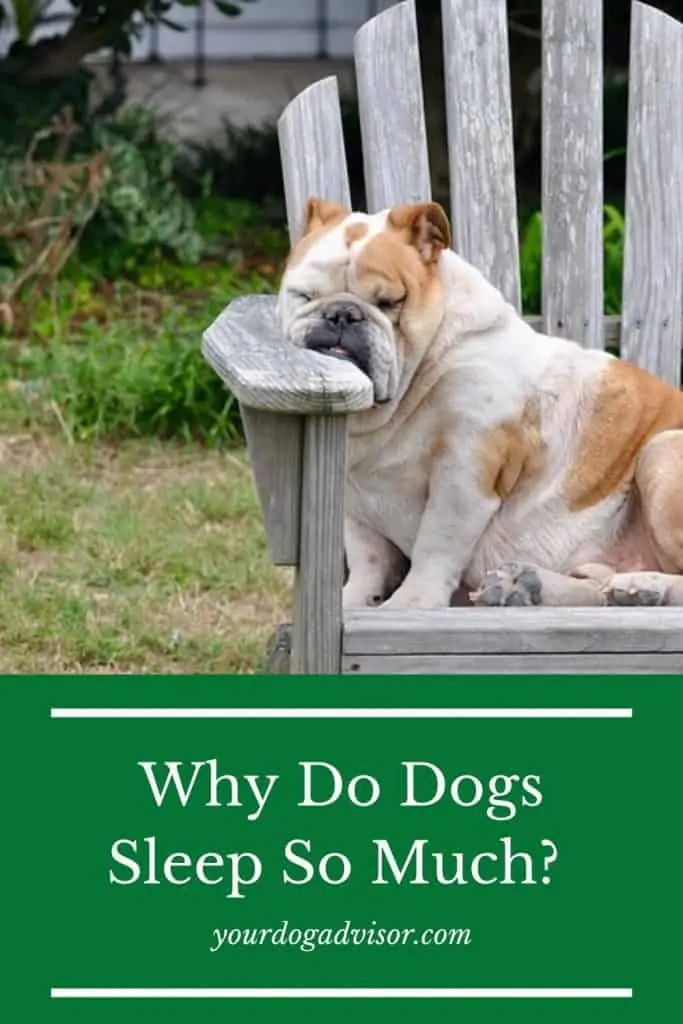

Jen Jones is a professional dog trainer and behavior specialist with more than 25 years of experience. As the founder of ‘Your Dog Advisor’ and the ‘Canine Connection’ rehabilitation center, she applies a holistic, empathetic approach, aiming to address root causes rather than merely treating symptoms.
Well known for her intuitive and compassionate approach, Jen adopts scientifically-proven, reward-based methods, encouraging positive reinforcement over punishment. Jen specializes in obedience training, behavior modification, and puppy socialization. Her innovative methods, particularly in addressing anxiety and aggression issues, have been widely recognized. Jen has worked with many of the world’s leading dog behaviorists and in her free time volunteers with local animal shelters and rescue groups.
